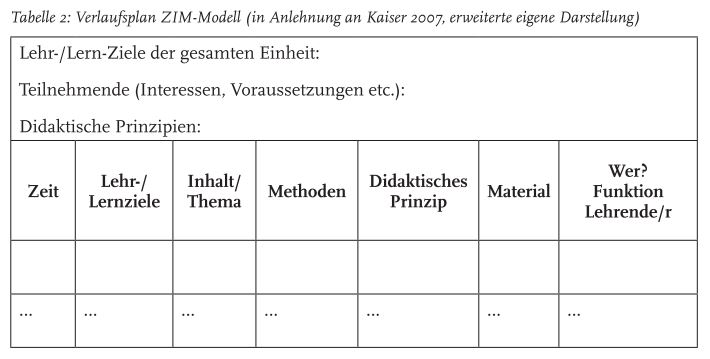Knowledge dimension of the HybrIDD course

Under the knowledge dimensions, we summarize characteristics in the context of which design decisions on teaching formats, teaching-learning objectives, learning content and learning times and for the HybrIDD room are made.
- We understand teaching-learning objectives as didactic goals that can be geared towards the acquisition of knowledge, skills or attitudes.
- Teaching formats include lectures, seminars and tutorials, each of which has specific structural characteristics: While seminars are characterized as discursive and exercises as practical, lectures are suitable for introducing a large number of students to a subject area.
- In addition, it must be determined what is to be learned. To this end, knowledge must be prepared, structured and sequenced and made available to students as learning content.
- Finally, learning time must be taken into account. By this we mean, on the one hand, the time scheduled by teachers for certain activities. On the other hand, we also understand it as the time experienced subjectively differently by individual students.

"Under the conditions of a hybrid-flexible organization of teaching and learning processes, professional action in [teaching] places great demands on situational action, but also on planning knowledge [...], which is particularly important for anticipating unforeseen events."
(Assinger & Gruber, 2022, S.95-96, translated from German)
-
On the one hand, synchronous-hybrid teaching-learning settings require good didactic planning. After all, it is not only decisions on teaching formats, teaching-learning objectives or learning content that need to be made. It is also important to think carefully about how much interaction should be implemented in the synchronous-hybrid teaching-learning settings and which methods and social forms should be implemented translocally (i.e. jointly by online and on-site participants). Plan templates (see “Materials for further use” below) can help with the detailed planning of individual sessions. On the other hand, a certain methodological and didactic flexibility is required to be able to respond to unforeseen circumstances. In synchronous-hybrid teaching-learning settings in particular, where students can decide from session to session how they want to participate (online or on-site), the proportion of on-site or online participants can change from session to session. This in turn has an impact on didactic (im)possibilities, such as the implementation of group work, if only one person participates online. In this case, we recommend checking the respective participation mode (online or on-site) before each session (see also “Materials for further use”).
-
As the hybrid implementation of courses is often unfamiliar to students at first, an introduction is required, for example in the form of training (see social setting), in the course of which the “pitfalls” and advantages of synchronous-hybrid teaching-learning settings are discussed. When navigating through a synchronous-hybrid teaching-learning setting, it also helps students if the individual sessions follow a similar structure (e.g. always a welcome, then input, then group work, etc.) and “public didactics” is used overall, i.e. didactic decisions are justified.
-
A shared “place” (e.g. a learning platform) in which learning content, tasks or work assignments are made accessible to everyone is particularly recommended for cross-location collaboration, for example in group work where online and on-site participants work together on a task. This reduces confusion and the feeling of being left alone, especially for online participants.
-
Finally, we found that it is important to address the different ways in which on-site and online participants experience learning time. For example, online participants need more breaks to maintain their ability to concentrate or a didactic approach to physicality. The latter can take the form of “energizers” during breaks, for example, during which online participants have to get up and become physically active.
From teachers for teachers: Tips for designing synchronous-hybrid teaching-learning settings
We asked teachers at the Professorship of Adult and Continuing Education what recommendations they would give other lecturers on the didactic and methodological design of synchronous-hybrid teaching and learning settings:
Planning synchronous-hybrid teaching-learning settings places high demands on teachers. They have to make didactic decisions about broad and detailed objectives, the timetable and the learning content. Plan templates such as those from von Hippel et al., 2022 , S. 111, are suitable as an aid:
In addition, however, teachers must also make didactically motivated decisions that relate specifically to the hybrid delivery of the course. We have developed the following reflection questions:
| Objective | What is the purpose of a hybrid course? (e.g. promotion of internationality) |
| Time conception | How often and for how long (once, several times or over the entire semester) should the hybrid course be held? |
| Course size and composition of participants | How many students will take part in total, how many online and how many on site? |
| Persons involved | Will I be teaching alone or in tandem with a colleague? Is there someone who will support me with the media equipment? |
| Places | From where do the participants (students, lecturers or external experts) take part? (e.g. from home, from another university, from abroad, etc.)? |
| Degree of interaction | How much interaction should be made possible? |
| Complexity of the media technology implementation | What media technology is available? How complex should the media technology setup be? |
| Degree of co-creation by the students | How can students be involved in the implementation of hybrid teaching? |
And finally, as we found out that students also make their participation behavior dependent on that of other students, teachers create polls on the learning platform in plenty of time before each session, which are set up so that all course participants can view the results of the poll. Students then vote before each session on whether they would like to take part in the hybrid course online or on site. This voting also helps the teachers, as they can adapt their didactic planning accordingly.
Breitschwerdt, L.; Hümmer, C. & Egetenmeyer, R. (2024). Gestaltungsanforderungen hybrider Settings in der Hochschullehre aus der Perspektive von Studierenden. Bildungsforschung. 30(1). https://doi.org/10.25539/bildungsforschung.v30i1.1029
Breitschwerdt, L.; Hümmer, C.; & Egetenmeyer, R. (in preparation). Umsetzung synchron-hybrider Settings an Hochschulen. Ein Erfahrungsbericht zur Ermöglichung ko-kreativer syn-chron-hybrider Lehr-Lern-Settings im Hochschulkontext. In Schmidt-Lauff S. (Hg.), (Trans-formative) Digitale Kompetenzen – Entwicklungen für Hochschule, Studium und Gesellschaft (S. NN). Wbv.
Foraster, M. J.; Egetenmeyer, R.; Soler-Gallart, M.; de Aguileta, A. L.; Flecha, R. (2023). Soler, Egetenmeyer, Lopez, Flecha (2023). Dialogic teaching beyond words. Multidisciplinary Journal of Educational Research, 13 (3), pp: 313 –324. DOI: https://doi.org/10.17583/remie.12867 In Citavi anzeigen
Hümmer, C.; Egetenmeyer, R.; Flecha, R. & Soler, M. (2024). Dialogisches Lehren jenseits von Worten – Forschungsergebnisse zu kommunikativen Handlungen in der hybriden Lehre. Erwachsenenbildung. Vierteljahresschrift für Theorie und Praxis. 70, 02, S. 68-71.
Hümmer, C. & Egetenmeyer, R. (in preparation). More than just a question of media technology? The design of Hybrid Learning Spaces. A literature review on current empirical findings in the German higher education landscape.
Hümmer, C.; Breitschwerdt, L. & Egetenmeyer, R. (in preparation). Forms of Hybrid Learning Spaces in Higher Education - a qualitative analysis.












